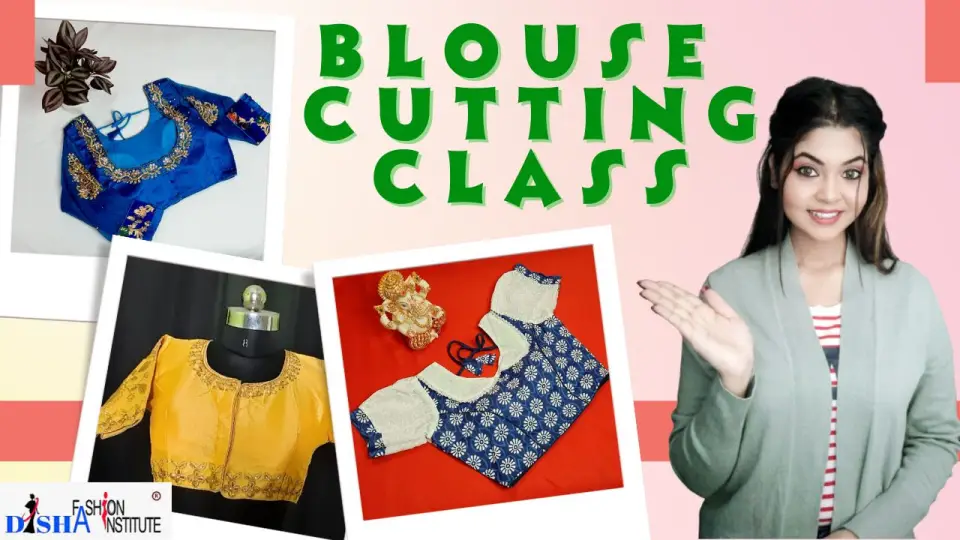Exploring the Art of Applique: From Historical Roots to Modern Techniques and DIY Tips
Applique is an ornamental needlework where a piece of fabric of different shapes is stuck or sewn onto a larger piece of fabric. The term “applique” originates from the Latin word “applico” which means “apply” and the French word “appliquer” which means “attach”. Applique is one of the oldest and finest decorative methods practiced in the world.
Applique is similar to traditional embroidery, which also involves the use of a needle and thread to add decorative elements to the fabric. But applique is different from traditional embroidery or this can be considered as a special type of embroidery because it uses small pieces of fabric to create a design, whereas traditional embroidery uses thread or yarn to create a design.
Table of Content
History of Appliques
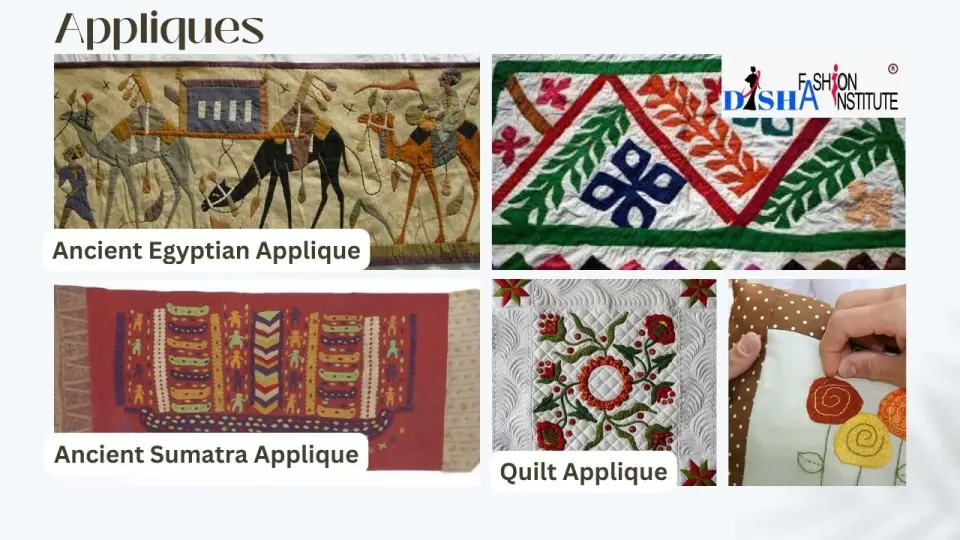
In the beginning, the method was used as a way to strengthen worn parts and holes of garments and other items. Archeologists have found ancient examples of appliques in Egypt, Siberia, Mongolia.
Today, appliqué is used all over the world as a way to embellish garments, decorative items for homes, bags, quilts, blankets. Appliqued cloth is a part of the tradition in different places like Benin, West Africa; Scandinivia, Russia and eastern Europe; India, Pakistan.
Appliques in India
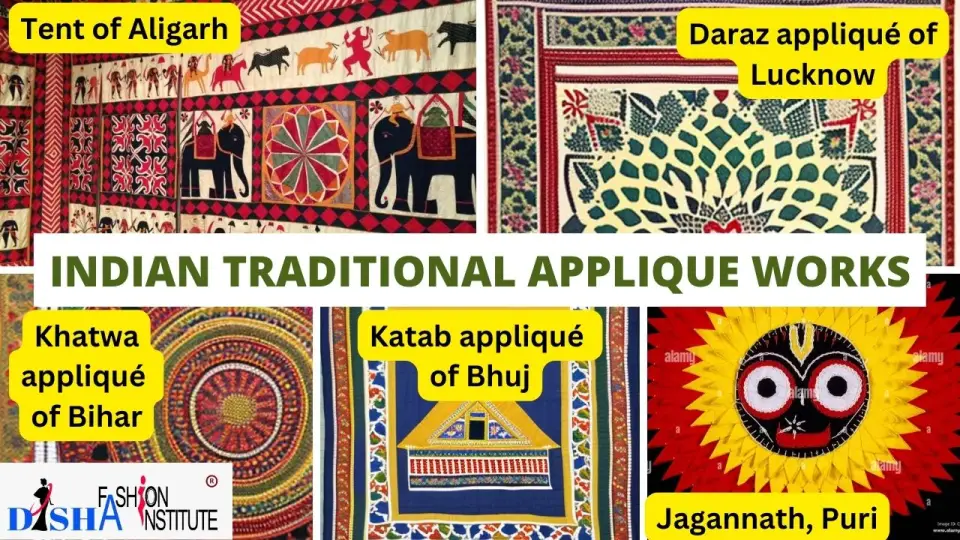
In India we can see that the appliques designs are quite popular in Ahmedabad, Saurashtra, Banaskantha, Patan and Kutch of Gujarat; Pipli and Puri of Odisha, different cities of Uttar Pradesh, Bihar, Madurai of Tamil Nadu etc. Today, Pipli,Odisha is poular worldwide to be the center for many artisans and workshops that still practice making traditional applique items. Applique shamiana or tents of Aligarh, Daraz appliqué of Lucknow, Tharu appliqué of UP, Uttarakhand and Bihar, Khatwa appliqué of Bihar, Katab appliqué of Bhuj are also worldwide popular.
Shamiana applique
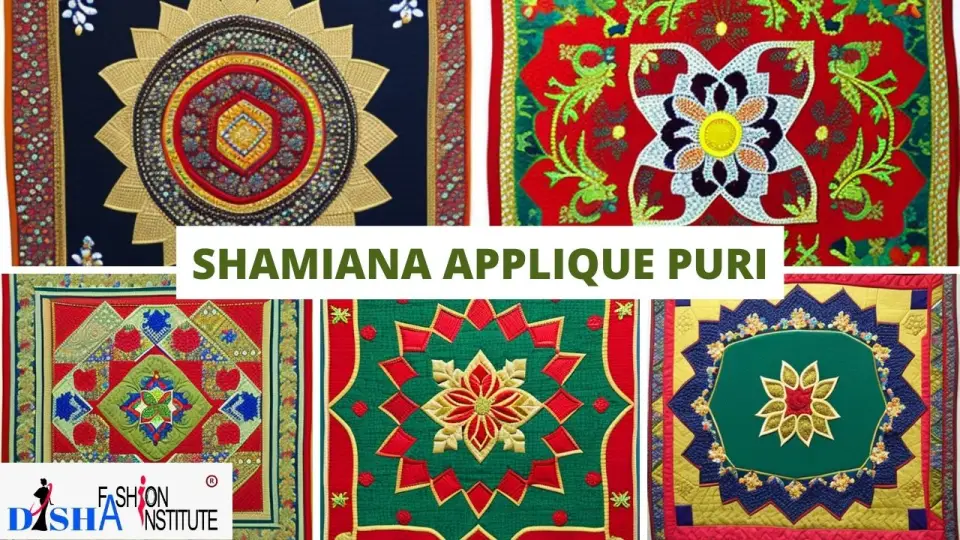
Shamiana applique is a traditional art form that originated in the Indian subcontinent, specifically in the northern region of India and Pakistan. The word "shamiana" is derived from the Persian word "shamshir", which means "tent". The technique is traditionally used to decorate tents and other forms of temporary structures, such as canopies, used for festivals and ceremonies.
The origins of shamiana applique can be traced back to the Mughal Empire, which ruled over much of the Indian subcontinent from the 16th to the 18th century. During this time, the Mughals brought a great deal of artistic and architectural influence to the region, and many of the techniques and styles used in shamiana applique today can be traced back to this period.
The traditional technique of shamiana applique involves cutting out pieces of fabric and sewing them onto a background fabric to create a design. The fabrics used can vary, but they are often lightweight and brightly colored, such as silk, chiffon, and cotton. The designs are typically very detailed and can include a wide range of different elements, including geometric patterns, floral designs, and religious symbols.
Over time, the shamiana applique technique has been adapted and evolved, and it is now used to decorate a wide range of different items, including clothing, bags, and home decor. The technique is still highly valued by artisans and is considered an important part of traditional culture and heritage.
In recent years, shamiana applique has gained popularity as a form of cultural tourism in India and Pakistan. Many tourists visit the region to learn about the traditional techniques and to purchase handcrafted items such as bags, clothing, and wall hangings made in shamiana applique. This helps to preserve the tradition and provides a source of income for the local artisans.
In conclusion, shamiana applique is a traditional art form that originated in the Indian subcontinent. It is a technique of cutting and sewing pieces of fabric onto a background fabric to create a design. The technique has its roots in the Mughal Empire and is traditionally used to decorate tents and other forms of temporary structures. Today, the technique is adapted and evolved and is used to decorate a wide range of different items and is considered an important part of traditional culture and heritage in India and Pakistan.
Tharu Applique of Terai Region in India and Nepal
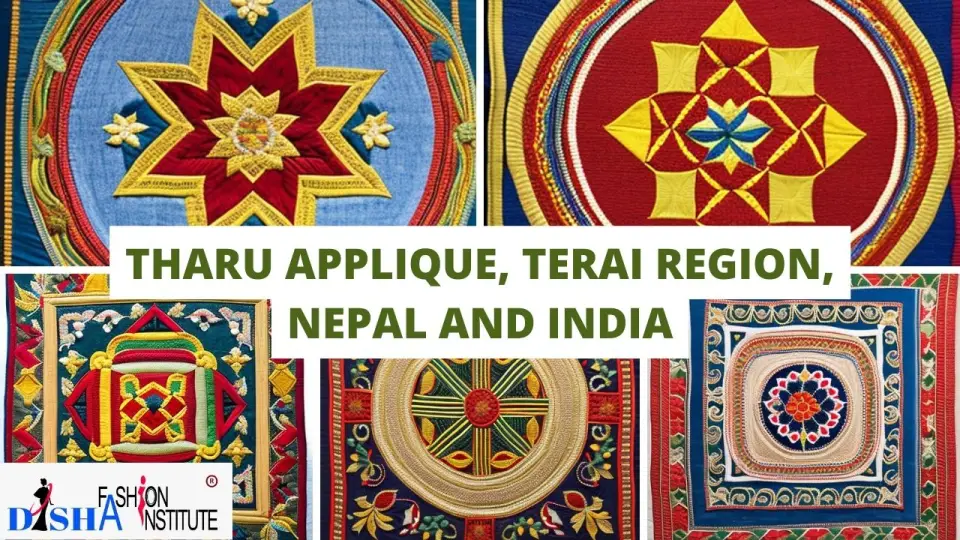
Tharu applique is a traditional art form that has been passed down through generations of the Tharu people in Nepal and India. The Tharu are an indigenous group who have lived in the Terai region of Nepal and Uttar Pradesh, Uttarakhand and Bihar region of India, for centuries. They have a rich cultural heritage that is reflected in their art and crafts, and applique is one of their most well-known forms of expression.
Applique is a technique in which pieces of fabric are cut out and sewn onto a background fabric to create a design. The Tharu use this technique to create intricate and colorful designs on clothing, bags, and other items. They use a variety of different fabrics, including cotton, silk, and satin, and they often incorporate traditional symbols and patterns into their designs.
One of the most distinctive features of Tharu applique is the use of bright, bold colors. The Tharu use a wide range of colors, including red, orange, yellow, green, blue, and purple. They often combine different colors in a single design to create a striking and vibrant effect.
Tharu applique is typically done by women, and it is often a collaborative process. Women will gather together to work on a project, and they will share ideas and techniques with one another. This helps to ensure that the finished product is of the highest quality and that the traditional techniques are passed down to future generations.
The Tharu people have a deep respect for their cultural heritage, and they are committed to preserving their traditional art forms. Applique is just one of the many ways in which they express their culture and their identity. When you see a piece of Tharu applique, you are seeing a piece of their history and their culture.
In recent years, Tharu applique has gained popularity as a form of cultural tourism in Nepal. Many tourists visit the Terai region to learn about the Tharu culture and to purchase handcrafted items such as bags, clothing, and wall hangings made in Tharu applique. This not only helps to preserve the tradition but also provides a source of income for the Tharu people.
In conclusion, Tharu Applique is a traditional art form of the Tharu people of Nepal and India. It is an intricate and colorful technique of sewing pieces of fabric onto a background fabric to create a design. The use of bright colors, traditional symbols and patterns make it a striking and vibrant form of art. The tradition is passed down from generation to generation and has become a popular form of cultural tourism in Nepal and some parts of India.
Examples of Items Made Using Appliqué Method
- Quilts
- Clothing such as shirts, dresses, and jackets
- Handbags and purses
- Wall hangings and tapestries
- Home decor items such as cushion covers and table runners
- Hats and caps
- Scarves and shawls
- Embellished jeans and denim jackets
- Embroidered patches on jeans and bags
- Decorative throw pillows.
and many more.
Methods of Applique
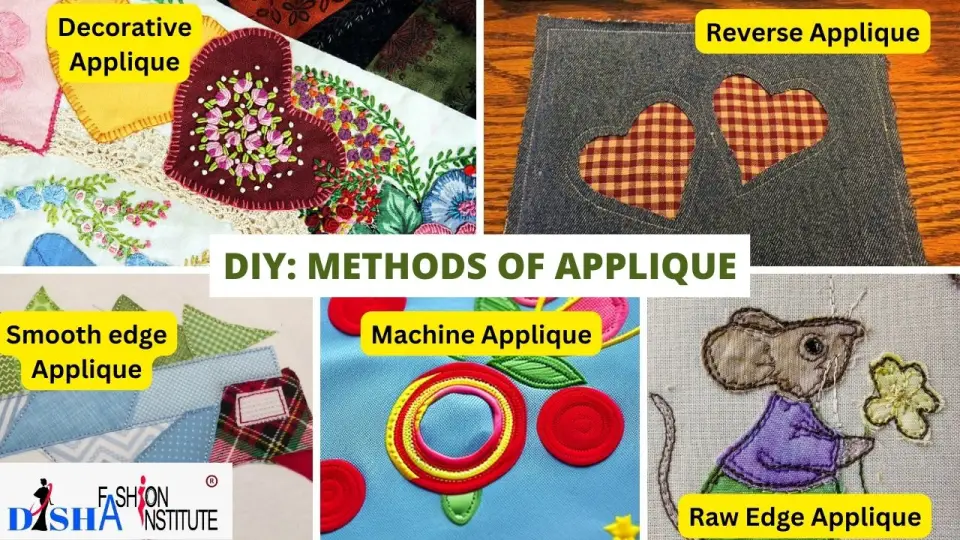
- Raw edge appliqué
- Reverse appliqué
- Smooth edge appliqué
Raw Edge Applique
One of the most popular methods of appliqué is the raw edge technique.
The raw edge technique is known for its unique and artistic look. The fabric pieces are cut into various shapes, and then attached to the background fabric without any additional stitching to cover the edges. This creates a layered and textured look that can add visual interest to any item.
However, it is important to note that the raw edge technique is not suitable for items that will be washed regularly or used daily. The reason for this is that the raw edges of the smaller fabrics are not sewn over, which means that they are not as strong as the rest of the item. This makes them more prone to tearing or fraying over time.
Therefore, if you are looking to make an item using the raw edge appliqué technique, it is best to use it on items that will not be washed regularly and that won't be used daily. Home decor items such as wall hangings, quilts, and decorative pillows are perfect examples of items that can be made using this method.
In conclusion, the raw edge appliqué technique is a great way to add a unique and artistic touch to any item. It is easy to learn and can be a fun and creative way to make something beautiful. However, it is important to be aware of the limitations of this technique and to use it only on items that will not be washed regularly or used daily.
Smooth Edge Applique
Smooth edge applique is a popular method of adding decorative elements to a wide range of items. Unlike raw edge applique, in this method, the raw edges of the smaller fabrics are covered by a decorative hand or machine stitches. This creates a polished and finished look that is more suitable for items that will be used regularly or washed frequently.
This method is commonly used on garments such as shirts, dresses, and jackets, as well as home decor items like cushions, bed sheets, blankets, and pouches. The decorative stitching not only adds visual interest to the item but also strengthens the smaller patches and prevents them from fraying or tearing.
One of the benefits of smooth edge applique is that it is versatile and can be used on a wide range of fabrics, from delicate silks to sturdy denim. The decorative stitching can also vary, from simple straight stitches to more complex patterns and designs.
In conclusion, smooth edge applique is a great method for adding decorative elements to items that will be used regularly or washed frequently. The decorative stitching not only adds visual interest but also strengthens the smaller patches, making the item more durable. It is a versatile technique that can be used on a wide range of fabrics and with a variety of decorative stitching options.
Hand stitches to cover the raw edge of applique
- Button-hole stitch
- Satin stitch
- Straight stitch
- Chain stitch
- Hem stitch
Machine stitches for appliqué:
Machine stitches are a great option for appliqué as they offer a wide range of options and can add a professional touch to the finished product. When it comes to machine stitches for applique, there are several options to choose from, each with its own unique look and purpose.
One popular option is the zigzag stitch. This is a versatile stitch that can be used to finish raw edges, as well as add decorative elements. The zigzag stitch can be adjusted to different widths and lengths, which makes it a great option for a wide range of fabrics.
Another popular option is the chain stitch. This is a decorative stitch that can be used to add a unique look to your applique. It creates a line of interlocking loops, which can be used to create a variety of patterns and designs. The chain stitch is best used on medium-weight fabrics and is great for adding texture and interest to your applique.
In addition to these, there are many other machine stitches that can be used for applique such as satin stitch, blanket stitch, straight stitch, buttonhole stitch and many more. These stitches can be used individually or in combination with other stitches to create unique designs and patterns.
In conclusion, Machine stitches are a great option for applique as they offer a wide range of options and can add a professional touch to the finished product. The zigzag stitch and chain stitch are popular options, but there are many other stitches available that can be used to create unique designs and patterns. The choice of stitch will depend on the type of fabric and the desired look of the finished product.
Reverse Applique
Reverse Applique is a unique and creative method of adding decorative elements to a variety of items. Instead of sewing patches onto the background fabric, fabrics are layered together and a pattern is stitched on the top layer. The top layer is then cut away according to the desired shape, revealing the layer of fabric that was underneath.
This technique is often used to create intricate and detailed designs, as it allows for a high level of precision and control when cutting away the top layer of fabric. The technique is best used on medium-weight fabrics, as the layers of fabric can be more difficult to manage on lightweight or heavy fabrics.
Reverse Applique can be done by hand or machine, and it can be used to create a wide range of designs. Some common examples include geometric patterns, floral designs, and abstract shapes. It can be used on clothing, home decor, and even on bags, wallets and many other items.
One of the benefits of Reverse Applique is that it can add a unique and interesting visual element to an item that can be quite striking. However, it can also be time-consuming and requires a high level of skill to execute well.
In conclusion, Reverse Applique is a unique and creative method of adding decorative elements to a variety of items. Instead of sewing patches onto the background fabric, fabrics are layered together and a pattern is stitched on the top layer. The top layer is then cut away according to the desired shape, revealing the layer of fabric that was underneath. It's a great way to add an intricate and detailed design to an item but it can be time-consuming and requires a high level of skill.
DIY Guide: How to Create Beautiful Applique Designs at Home
Before you begin, you'll need to gather a few supplies. First, you'll need a base fabric for your applique work. This can be any type of fabric, but it should be a solid color or a simple print that will allow the applique pieces to stand out. Next, you'll need to choose fabrics for your applique pieces. These fabrics should have contrasting colors and textures to the base fabric. You will also need a few tools like a pair of scissors, a needle, and thread that matches the color of your applique fabrics.
Learn how to do applique at home with this step-by-step guide by watching the video below.
Another video on Applique work. Watch end to end and practice at home. Comment your feedback.
Once you have all your materials ready, you can start preparing your applique pieces. You can either draw a design on the back of your applique fabrics, or use a pre-drawn template. Carefully cut out the shapes, making sure to leave a small seam allowance around the edges.
Now it's time to attach the applique pieces to your base fabric. First, position the applique pieces on the base fabric, making sure they're in the desired location. Then, you can use a few pins or baste the pieces in place.
You can use a sewing machine or hand-sew to attach the applique pieces to the base fabric. A small, invisible stitch is recommended to keep the edges of the applique pieces in place.
Finally, you can add any additional embellishments you like, such as beads or buttons, to give your applique work a unique touch.
Applique is a fun and easy technique that can be used to create a wide variety of designs, from simple shapes to more complex patterns. With a little practice, you'll be able to create beautiful applique pieces that will add a personal touch to all your sewing projects.
In conclusion, Applique is a great way to add a personal touch to your sewing projects, it's easy to learn and can be applied to a wide variety of designs. With the right materials and a little practice, you'll be able to create beautiful applique pieces that will add a personal touch to all your sewing projects.
![[DISHA] The Best Tailoring School](/media/plg_jspeed/cache/images/Disha_logo.webp)

